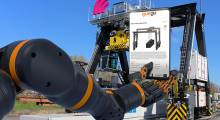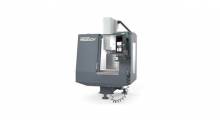As the processes, equipment and overall strategies of distribution centers and manufacturing plants are continuously responding to the ever-changing global marketplace, one part of the materials handling process has remained practically unchanged: dock equipment. However, a shift is occurring as DC and plant owners are beginning to focus on how to improve the effectiveness of their dock areas.
To help employees as they transport products from docks to trailers, some companies are incorporating loading and unloading robotics. Others are focusing on their manual dock products by replacing yellow steel guard railings with new types of barriers and installing new dock seals. Additionally, employee safety is a high priority as companies are acquiring equipment like roller conveyors and vehicle restraints.
Through each of these advancements, facilities are not only improving their operational efficiency and employee productivity—they are also preparing for the future of shipping, so they can remain ahead of the curve and continue to increase their bottom lines in the midst of continuous change.
Automation eases complexity
Despite the constant evolution of automation, most loading docks have yet to become automated. After all, humans are very flexible in their abilities to handle different types of loads, so a one-size-fits-all approach won’t work as different types of automation need to be applied depending on the type of load that has to be moved. But, companies are now starting to incorporate some automation in truck loading and unloading.
- Truck unloading robotics: To unload products, some companies are beginning to use industrial robots on mobile platforms that are attached to extendable conveyors. Featuring 3D vision, the robots autonomously move to trailers and either locate, grip or move products from the trailers to the extendable conveyors. “For unloading, the automation needs to know or find where products are within the trailer,” says Tim Criswell, senior vice president of innovation and technology development for Wynright, a wholly owned subsidiary of Daifuku North America Holding Co. “This requires the use of 3D vision technology and algorithms to logically find and separate the pile of product into individual units.” Only a few robots have been implemented into full-time production so far. But as the technology is refined, producing better cube utilization and less product damage, Criswell anticipates the adoption of robotics will begin to accelerate.
- Truck loading robotics: The same types of robots can be used to load products as well; the only difference, of course, is that the equipment operates in reverse, while also using software to measure products’ dimensions and determine where they should be placed in trailers. The products will either be loaded onto floor-loaded trailers, where products are stacked directly on floors, or they will be palletized so that larger volumes of products (1,500 to 2,500 pounds) can be moved in one operation. “For palletized loads, there are robotic and mechanized de-palletizing systems that move product from the pallet to a conveyor within the warehouse,” Criswell says. “The automation must also deploy a grasping mechanism that grips whichever product it wants to move without damaging products around it or hitting trailer walls. The method for grasping the product is influenced by the fact that it can be in a known position and separated from other products.”
Improving manual dock products
- Guard rails/barriers: For years, yellow steel guard railings have protected and separated dock workers from materials handling equipment and machinery—by withstanding an impact of 10,000 pounds at 4 mph. But, as the weights and speeds of materials handling equipment and loads have increased, the requirements and needs for these types of barriers have changed.
 Not only do the barriers need to be stronger to protect heavier loads that are moving at faster speeds, but they also have to be flexible to absorb the impacts of high speeds. The barriers must also be detachable, especially when access into a certain space is necessary. After all, steel guard railings have usually been anchored into the ground permanently, so they often weren’t used to protect areas that required access, particularly loading docks.
“This had led to the development of barriers comprised of fabric, plastics and other new materials—and a growing awareness that safety barriers are no longer a one-size-fits-all proposition,” says Troy Bergum, product manager at Rite-Hite. “Safety and facility managers need to become more sophisticated in their evaluations of barrier needs, analyzing location-specific traffic patterns and other issues, rather than just defaulting to steel that is heavy enough to withstand 10,000 pounds at 4 mph.”
Not only do the barriers need to be stronger to protect heavier loads that are moving at faster speeds, but they also have to be flexible to absorb the impacts of high speeds. The barriers must also be detachable, especially when access into a certain space is necessary. After all, steel guard railings have usually been anchored into the ground permanently, so they often weren’t used to protect areas that required access, particularly loading docks.
“This had led to the development of barriers comprised of fabric, plastics and other new materials—and a growing awareness that safety barriers are no longer a one-size-fits-all proposition,” says Troy Bergum, product manager at Rite-Hite. “Safety and facility managers need to become more sophisticated in their evaluations of barrier needs, analyzing location-specific traffic patterns and other issues, rather than just defaulting to steel that is heavy enough to withstand 10,000 pounds at 4 mph.” - Dock seals: In addition, another means of protection—dock seals—are also being replaced with new alternatives, as they do not currently have the longevity they once did, primarily due to a rise in abrasions created by trailers during the loading process. To improve their longevity, Entrematic has developed a new line of dock seals with fabric that they say provides more than 10 times the abrasion resistance.
 “The seals also include other high-end features to reduce wear and improve the closure of the gaps found at a typical dock,” explains John Carroll, director of U.S. sales of loading dock products for Entrematic.
“The seals also include other high-end features to reduce wear and improve the closure of the gaps found at a typical dock,” explains John Carroll, director of U.S. sales of loading dock products for Entrematic. - Dock lifts: Leased buildings or unconventional industrial spaces are often not equipped with dock lifts or levelers. Installation is typically not an option either, as many companies have only committed to short-term leases and can’t make permanent improvements to properties they won’t ultimately occupy. As an alternative to dock lifts and levelers, companies can install surface mount lifts instead, which can be removed and transported elsewhere.
 “Since surface mount lifts’ hydraulic systems are pre-plumbed and their electrical is pre-wired, installation is quick, easy and can be done for a fraction of the cost of a pit-mounted lift,” says Pete Norden, dock lift program manager for Southworth Products Corp. “The surface mount lifts also have low collapsed heights, which allow for shorter ramps, resulting in a big space savings.”
“Since surface mount lifts’ hydraulic systems are pre-plumbed and their electrical is pre-wired, installation is quick, easy and can be done for a fraction of the cost of a pit-mounted lift,” says Pete Norden, dock lift program manager for Southworth Products Corp. “The surface mount lifts also have low collapsed heights, which allow for shorter ramps, resulting in a big space savings.” - Standard vehicle restraints: Another common issue at the dock is that many intermodal container chassis currently have a rear impact guard obstruction that creates a challenge to properly restrain trailers with standard vehicle restraints. To solve this issue, Rite-Hite has developed technology that secures standard, over-the-road trailers, as well as intermodal container chassis. “There is not a ‘one-product-fits-all’ design mentality when it comes to safely securing trailers in today’s diverse loading dock environment,” says Rite-Hite’s Bergum. “Rite Hite’s technology is designed and engineered for such challenging applications, as the company consults with customers to determine which products best suit their needs. In doing so, employees will be safe and customers will not have to evaluate every trailer that pulls into the loading docks to determine whether they are secured by vehicle restraints or if they have obstructions that create safety challenges.”
Investing in employee safety and ergonomics
Suppliers report an increased focus on dock safety and ergonomics, particularly with regard to employees that unload floor-stacked containers and trailers. Employee turnover can be high in this area as well, since workers are required to use step stools or climb on boxes to reach items that are stacked above their heads.
“Where much time, effort and capital is spent on the loading operation, warehouse management system and order picking side of the operation, the unloading operation generally requires employees to mainly perform manual labor as they hand stack boxes on pallets,” says Richard Kat, vice president of sales and marketing for Engineered Lifting Systems and Equipment. “Equipment such as flexible powered roller conveyors and extendable belt conveyors—as well as ergonomic machines that provide assistance to workers that unload products—are finding their way into warehouses and DCs.”
As companies invest more in employee safety and ergonomics, they are using more powered dock equipment and vehicle restraints. As they do, they are also expecting better control features, as well as the ability to sequence the order of operation for their equipment.
Enhanced controls were once viewed as optional additions to dock packages, but they are now considered a necessity. In fact, according to Entrematic’s Carroll, the percentage of dock packages sold with enhanced controls has increased the last two years, and he expects a continued rise in the future.
“We are also seeing much higher interest in dock and yard management systems as companies continue to pursue operational improvements,” Carroll says. “These systems can greatly reduce the cycle time for loading and unloading products, as well as the movement of traffic in and out of facilities.”
About the Author
Follow Robotics 24/7 on Linkedin
About the Author
Follow Robotics 24/7 on Linkedin
Article topics
Email Sign Up















